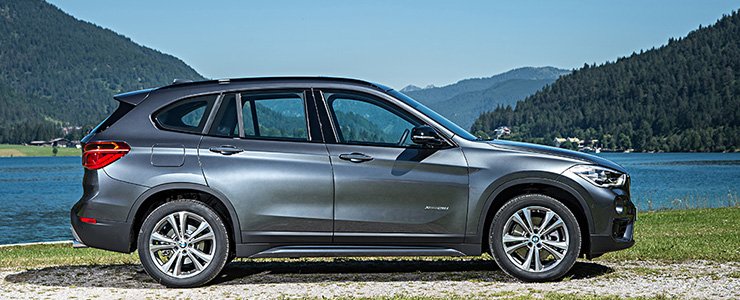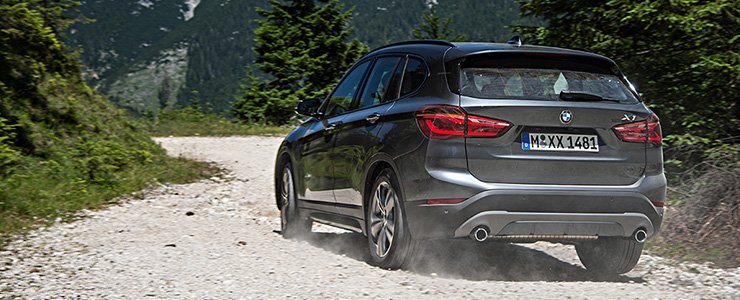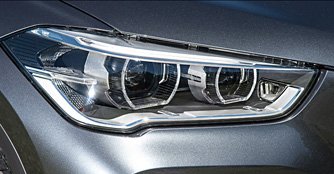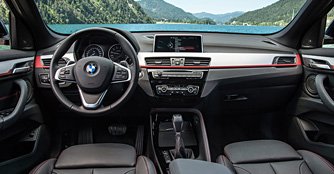BMW X1 xDrive25i Sport (A) First Drive Review
30 Jul 2015|25,776 views
Do you remember the last time you were doubtful about something, only to have it turn out to be a pleasant surprise? Such was the feeling when we went for a spin in BMW's new X1 in Austria.
New from the ground up, the second generation X1 is an altogether different machine to the original, courtesy of a switch to BMW's flexible UKL architecture that is also shared by the 2 Series Active Tourer and the latest MINI range.
Where the old X1 was based on the 3 Series Touring and offered in rear or all-wheel drive, the new car now has the choice of all-wheel grip (xDrive) or front-wheel drive sDrive variants.
Exterior
The shift in platform has also allowed BMW to address an X1 niggle - packaging. According to exterior designer Calvin Luk, "the car has more 'X-ness' now", and we definitely agree. Unlike its predecessor that was more stationwagon-like, the new car is immediately more imposing and SUV-like to look at now, with loads of sharp creases, flared arches and a more aggressive styling.
 |
Ditching its predecessor's snouty, oversized bonnet and ungainly stance, the car has achieved a look that's well-proportioned and, especially from the front, handsome. The sides are also more heavily structured and together with greater ground clearance and an angled tailgate, the car brings on a more rugged appearance.
BMW's new baby X model definitely follows the form of the brand's larger utility vehicles and looks like a scaled down X3 or X5. Standing at 4,439mm x 1,821mm x 1,598mm (L x W x H), it is 15mm shorter than its predecessor but has grown 23mm wider and 53mm taller.
 |
Interior
In combination with the altered exterior dimensions, the new platform is crucial in providing greater levels of interior accommodation.
Although the wheelbase has shrunk by 90mm to 2,670mm, the cabin is able to offer more space and a better view out thanks to higher set, stadium-style seats that is a result of the magic of transverse engine packaging.
But more importantly, sitting taller doesn't mean less headroom. In fact, the roominess of the BMW is outstanding and it does feel more spacious than some of its rivals like the Audi Q3 and the Mercedes-Benz GLA-Class.
Room at the back is also generous with an increase of 37mm in knee room, and with the fore-and-aft slider option of the rear seats activated, the 66mm increase in knee space is especially impressive.
What has also increased is the cargo area. The new 505-litre boot has swelled by 85 litres over its predecessor, allowing for more luggage or golf bags.
The X1's cabin remains faithful to the style of the predecessor, and includes large door pockets with bottle holders, a compartment integrated within the lower dash fascia, cup holders and other cubby holes for sufficient storage.
The well-executed centre console with quality materials, which resembles that of the 2 Series Active Tourer, also ensures the controls are within easy reach of the driver.
 |
The Drive
Powering our xDrive25i test car is BMW's brand new 2.0-litre four-cylinder turbocharged B48 engine that develops 231bhp and 350Nm of torque.
Punchy low end properties and a willingness to rev freely are fully reflected in the way the motor whips the X1 to 100km/h in just 6.5 seconds. The fact that the throttle responds with much eagerness certainly makes the century sprint feel a lot faster than its suggested figure.
Mated harmoniously to a new eight-speed automatic transmission, the new engine is one of the smoothest among turbocharged four-pots.
What is also really noticeable is the great improvement in the shift quality of the transmission, which is now supplied by Japanese specialist Aisin instead of BMW's traditional automatic gearbox supplier, ZF.
While the new front-wheel drive architecture may trouble a few BMW purists, the real world translation is nowhere near as bad as you may imagine.
The car may not be as sharp as a 3 Series or the old X1, but is still entertaining to drive, and the intelligent xDrive all-wheel drive system, which can send up to 100 percent power to the front or rear when either axle senses slip, offers plenty of grip.
Steering is direct and body control is kept nicely in check - even with the dampers in their most comfortable setting. It's a significant step up both in terms of dynamics and ride comfort. It simply goes to show that a front-wheel drive bias SUV doesn't need to compromise on its sporty character.
Conclusion
While the new X1 may lack the car-like dynamics of its predecessor, we reckon it's only a small complaint as the main demographic will likely spend most of their time doing city driving and conquering the occasional dirt road - two tasks that this small SUV will do tremendously well.
And in a segment where practicality, equipment, efficiency and usability carry greater weight than on-the-limit handling, this car is a marked improvement.
We'll see how it performs again when it lands here in the third quarter of this year, but until then there's little doubt that the X1 has the element of surprise.
Do you remember the last time you were doubtful about something, only to have it turn out to be a pleasant surprise? Such was the feeling when we went for a spin in BMW's new X1 in Austria.
New from the ground up, the second generation X1 is an altogether different machine to the original, courtesy of a switch to BMW's flexible UKL architecture that is also shared by the 2 Series Active Tourer and the latest MINI range.
Where the old X1 was based on the 3 Series Touring and offered in rear or all-wheel drive, the new car now has the choice of all-wheel grip (xDrive) or front-wheel drive sDrive variants.
Exterior
The shift in platform has also allowed BMW to address an X1 niggle - packaging. According to exterior designer Calvin Luk, "the car has more 'X-ness' now", and we definitely agree. Unlike its predecessor that was more stationwagon-like, the new car is immediately more imposing and SUV-like to look at now, with loads of sharp creases, flared arches and a more aggressive styling.
Ditching its predecessor's snouty, oversized bonnet and ungainly stance, the car has achieved a look that's well-proportioned and, especially from the front, handsome. The sides are also more heavily structured and together with greater ground clearance and an angled tailgate, the car brings on a more rugged appearance.
BMW's new baby X model definitely follows the form of the brand's larger utility vehicles and looks like a scaled down X3 or X5. Standing at 4,439mm x 1,821mm x 1,598mm (L x W x H), it is 15mm shorter than its predecessor but has grown 23mm wider and 53mm taller.
BMW's new baby X model definitely follows the form of the brand's larger utility vehicles and looks like a scaled down X3 or X5. Standing at 4,439mm x 1,821mm x 1,598mm (L x W x H), it is 15mm shorter than its predecessor but has grown 23mm wider and 53mm taller.
Interior
In combination with the altered exterior dimensions, the new platform is crucial in providing greater levels of interior accommodation.
Although the wheelbase has shrunk by 90mm to 2,670mm, the cabin is able to offer more space and a better view out thanks to higher set, stadium-style seats that is a result of the magic of transverse engine packaging.
But more importantly, sitting taller doesn't mean less headroom. In fact, the roominess of the BMW is outstanding and it does feel more spacious than some of its rivals like the Audi Q3 and the Mercedes-Benz GLA-Class.
In combination with the altered exterior dimensions, the new platform is crucial in providing greater levels of interior accommodation.
Although the wheelbase has shrunk by 90mm to 2,670mm, the cabin is able to offer more space and a better view out thanks to higher set, stadium-style seats that is a result of the magic of transverse engine packaging.
But more importantly, sitting taller doesn't mean less headroom. In fact, the roominess of the BMW is outstanding and it does feel more spacious than some of its rivals like the Audi Q3 and the Mercedes-Benz GLA-Class.
Room at the back is also generous with an increase of 37mm in knee room, and with the fore-and-aft slider option of the rear seats activated, the 66mm increase in knee space is especially impressive.
What has also increased is the cargo area. The new 505-litre boot has swelled by 85 litres over its predecessor, allowing for more luggage or golf bags.
The X1's cabin remains faithful to the style of the predecessor, and includes large door pockets with bottle holders, a compartment integrated within the lower dash fascia, cup holders and other cubby holes for sufficient storage.
The well-executed centre console with quality materials, which resembles that of the 2 Series Active Tourer, also ensures the controls are within easy reach of the driver.
The Drive
Powering our xDrive25i test car is BMW's brand new 2.0-litre four-cylinder turbocharged B48 engine that develops 231bhp and 350Nm of torque.
Punchy low end properties and a willingness to rev freely are fully reflected in the way the motor whips the X1 to 100km/h in just 6.5 seconds. The fact that the throttle responds with much eagerness certainly makes the century sprint feel a lot faster than its suggested figure.
Mated harmoniously to a new eight-speed automatic transmission, the new engine is one of the smoothest among turbocharged four-pots.
What is also really noticeable is the great improvement in the shift quality of the transmission, which is now supplied by Japanese specialist Aisin instead of BMW's traditional automatic gearbox supplier, ZF.
While the new front-wheel drive architecture may trouble a few BMW purists, the real world translation is nowhere near as bad as you may imagine.
The car may not be as sharp as a 3 Series or the old X1, but is still entertaining to drive, and the intelligent xDrive all-wheel drive system, which can send up to 100 percent power to the front or rear when either axle senses slip, offers plenty of grip.
Powering our xDrive25i test car is BMW's brand new 2.0-litre four-cylinder turbocharged B48 engine that develops 231bhp and 350Nm of torque.
Punchy low end properties and a willingness to rev freely are fully reflected in the way the motor whips the X1 to 100km/h in just 6.5 seconds. The fact that the throttle responds with much eagerness certainly makes the century sprint feel a lot faster than its suggested figure.
Mated harmoniously to a new eight-speed automatic transmission, the new engine is one of the smoothest among turbocharged four-pots.
What is also really noticeable is the great improvement in the shift quality of the transmission, which is now supplied by Japanese specialist Aisin instead of BMW's traditional automatic gearbox supplier, ZF.
While the new front-wheel drive architecture may trouble a few BMW purists, the real world translation is nowhere near as bad as you may imagine.
The car may not be as sharp as a 3 Series or the old X1, but is still entertaining to drive, and the intelligent xDrive all-wheel drive system, which can send up to 100 percent power to the front or rear when either axle senses slip, offers plenty of grip.
Steering is direct and body control is kept nicely in check - even with the dampers in their most comfortable setting. It's a significant step up both in terms of dynamics and ride comfort. It simply goes to show that a front-wheel drive bias SUV doesn't need to compromise on its sporty character.
Conclusion
While the new X1 may lack the car-like dynamics of its predecessor, we reckon it's only a small complaint as the main demographic will likely spend most of their time doing city driving and conquering the occasional dirt road - two tasks that this small SUV will do tremendously well.
And in a segment where practicality, equipment, efficiency and usability carry greater weight than on-the-limit handling, this car is a marked improvement.
We'll see how it performs again when it lands here in the third quarter of this year, but until then there's little doubt that the X1 has the element of surprise.
Thank You For Your Subscription.









































